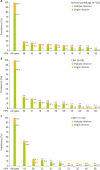High-risk human papillomavirus genotype distribution and attribution to cervical cancer and precancerous lesions in a rural Chinese population
- PMID: 28541628
- PMCID: PMC5447139
- DOI: 10.3802/jgo.2017.28.e30
High-risk human papillomavirus genotype distribution and attribution to cervical cancer and precancerous lesions in a rural Chinese population
Abstract
Objective: To explore the genotype distribution of high-risk human papillomavirus (HR-HPV) and its attribution to different grades of cervical lesions in rural China, which will contribute to type-specific HPV screening tests and the development of new polyvalent HPV vaccines among the Chinese population.
Methods: One thousand two hundred ninety-two subjects were followed based on the Shanxi Province Cervical Cancer Screening Study I (SPOCCS-I), and screened by HPV DNA testing (hybrid capture® 2 [HC2]), liquid-based cytology (LBC), and if necessary, directed or random colposcopy-guided quadrant biopsies. HPV genotyping with linear inverse probe hybridization (SPF10-PCR-LiPA) was performed in HC2 positive specimens. Attribution of specific HR-HPV type to different grades of cervical lesions was estimated using a fractional contribution approach.
Results: After excluding incomplete data, 1,274 women were included in the final statistical analysis. Fifteen point two percent (194/1,274) of women were HR-HPV positive for any of 13 HR-HPV types (HPV16, 18, 31, 33, 35, 39, 45, 51, 52, 56, 58, 59, and 68) and the most common HR-HPV types were HPV16 (19.1%) and HPV52 (16.5%). The genotypes most frequently detected in HR-HPV-positive cervical intraepithelial neoplasia grade 1 (CIN1) were HPV52 (24.1%), HPV31 (20.7%), HPV16 (13.8%), HPV33 (13.8%), HPV39 (10.3%), and HPV56 (10.3%); in HR-HPV-positive cervical intraepithelial neoplasia grade 2 or worse (CIN2+): HPV16 (53.1%), HPV58 (15.6%), HPV33 (12.5%), HPV51 (9.4%), and HPV52 (6.3%). HPV52, 31, 16, 33, 39, and 56 together contributed to 89.7% of HR-HPV-positive CIN1, and HPV16, 33, 58, 51, and 52 together contributed to 87.5% of CIN2+.
Conclusion: In summary, we found substantial differences in prevalence and attribution of CINs between different oncogenic HPV types in a rural Chinese population, especially for HPV16, 31, 33, 52, and 58. These differences may be relevant for both clinical management and the design of preventive strategies.
Keywords: Cervical Cancer; Cervical Intraepithelial Neoplasia; Genotype; Human Papillomavirus.
Copyright © 2017. Asian Society of Gynecologic Oncology, Korean Society of Gynecologic Oncology
Conflict of interest statement
No potential conflict of interest relevant to this article was reported.
Figures


References
-
- Ferlay J, Soerjomataram I, Ervik M, Dikshit R, Eser S, Mathers C, et al. GLOBOCAN 2012: estimated cancer incidence, mortality and prevalence worldwide in 2012 v1.0 [Internet] Lyon: International Agency for Research on Cancer; 2013. [cited 2014 Dec 19]. Available from: http://globocan.iarc.fr.
-
- Chen W, Zheng R, Baade PD, Zhang S, Zeng H, Bray F, et al. Cancer statistics in China, 2015. CA Cancer J Clin. 2016;66:115–132. - PubMed
-
- Shi JF, Canfell K, Lew JB, Qiao YL. The burden of cervical cancer in China: synthesis of the evidence. Int J Cancer. 2012;130:641–652. - PubMed
-
- Walboomers JM, Jacobs MV, Manos MM, Bosch FX, Kummer JA, Shah KV, et al. Human papillomavirus is a necessary cause of invasive cervical cancer worldwide. J Pathol. 1999;189:12–19. - PubMed
-
- zur Hausen H. Papillomaviruses in human cancers. Proc Assoc Am Physicians. 1999;111:581–587. - PubMed
MeSH terms
Substances
LinkOut - more resources
Full Text Sources
Other Literature Sources
Medical
Research Materials

